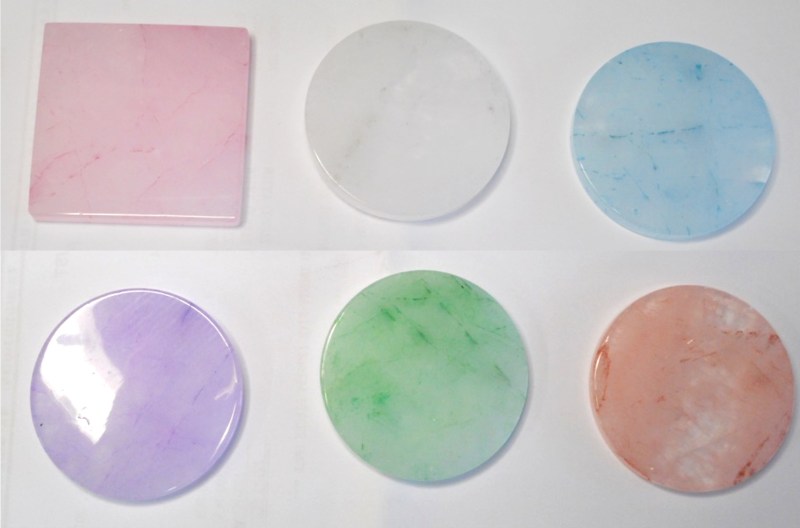Yesterday we published a first look at the hardware found on the DEF CON 27 badge. Sporting a magnetically coupled wireless communications scheme rather than an RF-based one, and an interesting way to attach the lanyard both caught my attention right away. But the gemstone faceplate and LED diffuser has its own incredible backstory you don’t want to miss.
This morning Joe Grand — badge maker for this year and many of the glory years of hardware badges up through DC18 — took the stage to share his story of conceptualizing, prototyping, and shepherding the manufacturing process for 28,500 badges. Imagine the pressure of delivering a delightful concept, on-time, and on budget… well, almost on budget. During the talk he spilled the beans on the quartz crystal hanging off the front side of every PCB.
Let’s Talk Gemstones
Wait, before you click away, believe me that the gemstone is at least as interesting as the electronics on this badge. Sure, you can go right now and order yourself a microcontroller, LEDs, and all the other bits shown on the circuit board. But you’ll have a decidedly harder time sourcing the disk of quartz that makes up the heft of this badge as its centerpiece and LED diffuser.
Joe made a lot of jokes about living in Portland, where there’s “a new-age crystal shop on every corner”. But his local vendors laughed when he approached them about sourcing 30,000 gemstones for the badge project. But they did give him the idea of swinging by the Tucson gem show, which is where his trip down the rabbit hole truly began. The gem con was full of wholesalers who themselves couldn’t supply the kind of quantity he actually needed, but they did hook him up with introductions to factories that were ready for a custom order.
The quartz is pulled out of the ground at a mine in Brazil as raw crystals about the size of a ridiculously heavy rugby ball. They’re shipped to a factory in China, where the labor-intensive process of turning them into a glossy coaster takes place.
The rough quartz is sliced to the approximately 5 mm finished thickness, before having the circle traced by hand. It’s then cut down to the lines on a wet saw, and hand-finished to final shape on a grinding wheel. A trip through a vibrating media polisher gives the surface a clear glass-like finish.
Joe had assumed this would be a much different process, possibly starting with a core-sample type of drilling process. But the nature of the stone itself seems to require a human eye for where to cut and where to place the final shape of the stone in each slice. General admission badges — known as Human — are used as-is. All of the “In-Human” badges (Speakers, Press, Goons which are the security staff) were dyed a color to match badge type.
These gems are a really special touch, even if the effort that goes into them is likely to be lost on most of the nearly 30,000 people at DEF CON this year. I’m glad that Joe Grand spent time in his talk to illuminate the backstory in this highly-involved little touch that literally makes every single badge unique. You can find the slides from his talk along with badge hardware info on the DEF CON media server.























“I’m glad that Joe Gran spent time in his talk”
What was that son? Can you give me my dentures?
What is a cost per piece? $0.5@30k hot/cold?
Although the wet processes shown are likely safe enough, assuming adequate exhaust ventilation, the mask he is wearing in the photo would be quite inadequate for respirable silica dust exposure.
RIP that dude. The mine in Brazil is probably nightmarish as well.
I bet the guy who made these badges won’t get the abuse for his supply chain labor practices that Apple gets.
The size of footballs, available in multiples of tens of thousands, processed in bulk by cheap Chinese labour and inexpensive enough to use as a diffuser on a conference badge. This is a definition of “gemstone” I wasn’t previously familiar with.
pretty much every rock that’s crystalline and used for decoration/jewelry/… is a “gem stone”.
Joe Grand, Mr Jtagulator. The pink gem version would fit on the Jtagulator and blink when JTAG is found!
2 contenders for World’s Largest Geode
http://yourcrystaljourney.com/the-worlds-largest-geode/
Is there a recording available somewhere?
lol, slave labor, hilarious.
#BadgeDeath
“All of the “In-Human” badges (Speakers, Press, Goons which are the security staff) were dyed a color to match badge type.”
This statement is incorrect/inaccurate.
Contest badges were yellow on the rear, but were not dyed yellow, making it super hard to find a yellow badge. Not sure why they turned out that way. I’m holding one in my hand right now.